bahama flier
Pre-takeoff checklist
Left for the Bahamas tried to open flight plan, no answer... had to get Orlando class B clearance, called and called no answer.... then I checked my radio for the transmit light... it was not coming on,,, crap, crap, crap, or something like that.
U turn back to my airport, I could hear but not transmit, no tower at my airport, so I watched the pattern and jumped in and did a quick landing and got off the runway.
I have a portable radio, but it was under stuff in the back of the airplane, (Cherokee six) seats out, lot of stuff. I know the portable should be in easy reach,, duh, in 900 hours never used it,, did not think about it. Never used my ELT either, my life jackets, or my inflatable raft, but they are in easy reach,,, why did I bury my portable radio, I don't know,,,
My Bahamas trip was cancelled, my audio panel in the shop, my portable radio would not have made me to continue on to Bahamas, but I would have made a safer return to my airport. My portable radio usually is clipped to the side panel by me during flight, but now its also on my check list.
U turn back to my airport, I could hear but not transmit, no tower at my airport, so I watched the pattern and jumped in and did a quick landing and got off the runway.
I have a portable radio, but it was under stuff in the back of the airplane, (Cherokee six) seats out, lot of stuff. I know the portable should be in easy reach,, duh, in 900 hours never used it,, did not think about it. Never used my ELT either, my life jackets, or my inflatable raft, but they are in easy reach,,, why did I bury my portable radio, I don't know,,,
My Bahamas trip was cancelled, my audio panel in the shop, my portable radio would not have made me to continue on to Bahamas, but I would have made a safer return to my airport. My portable radio usually is clipped to the side panel by me during flight, but now its also on my check list.

